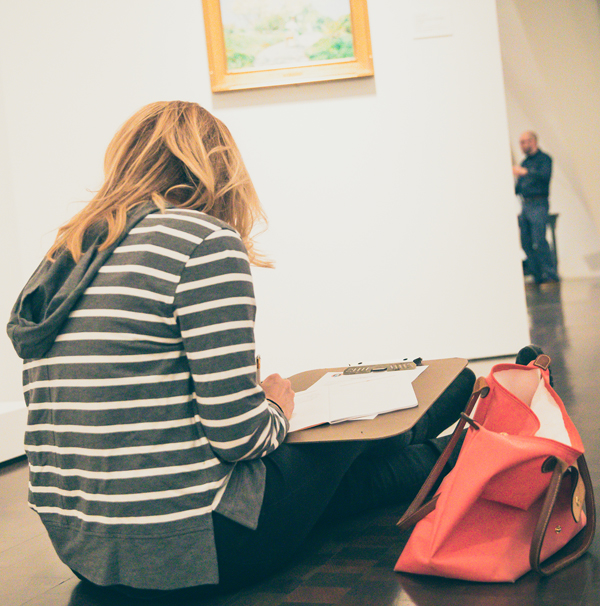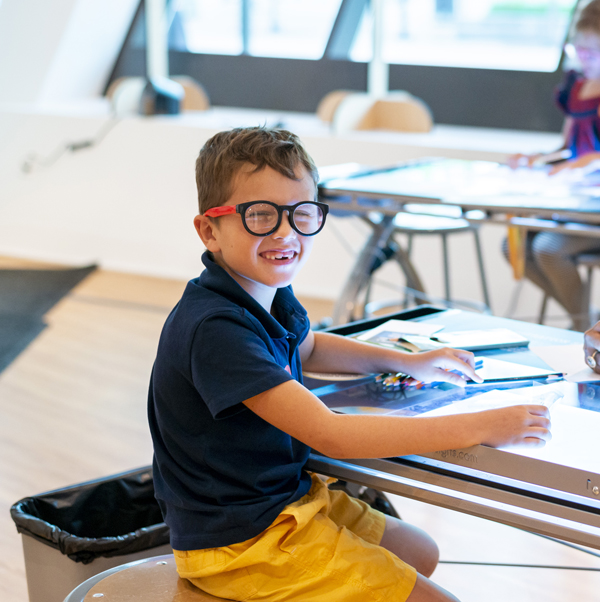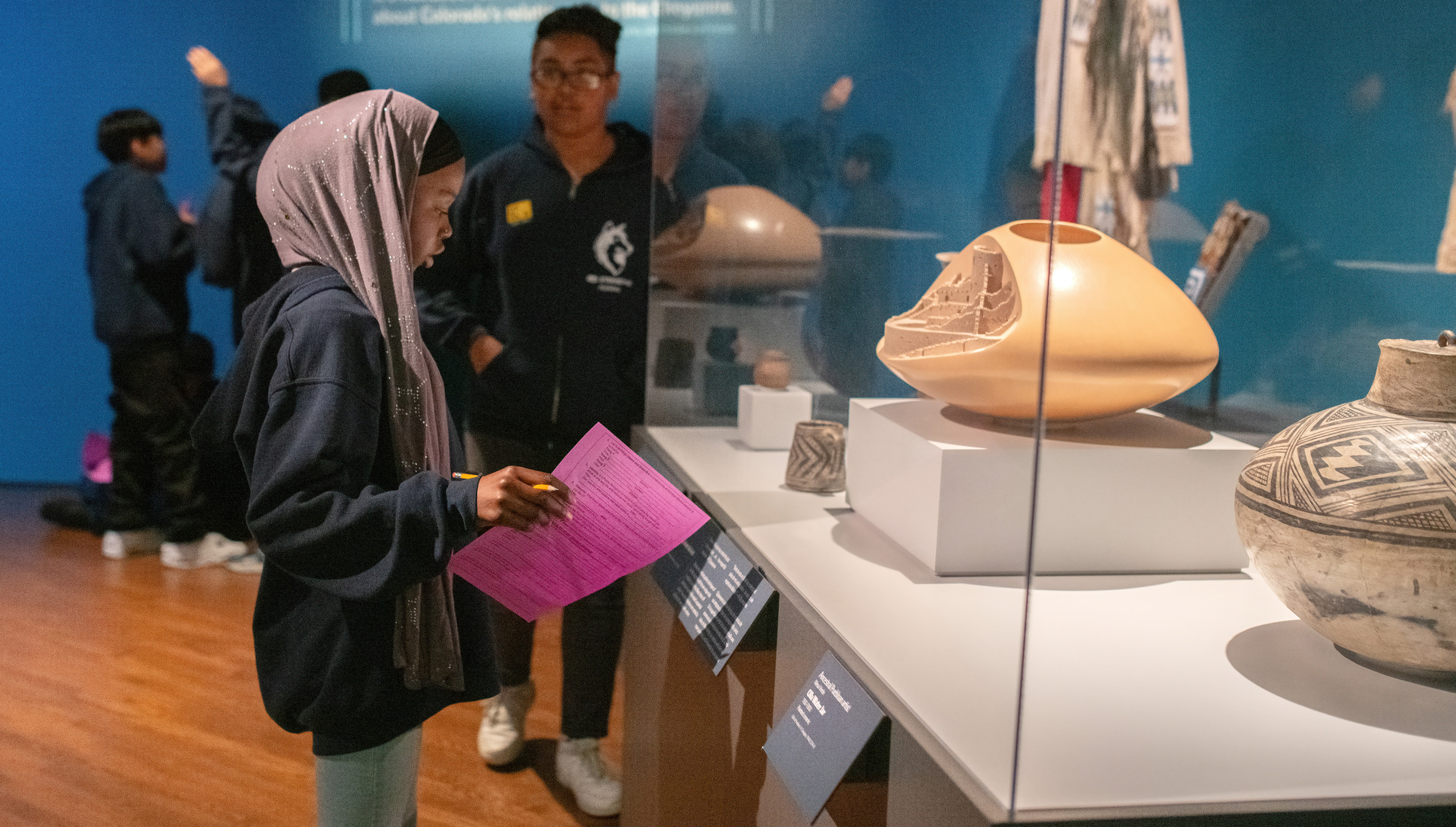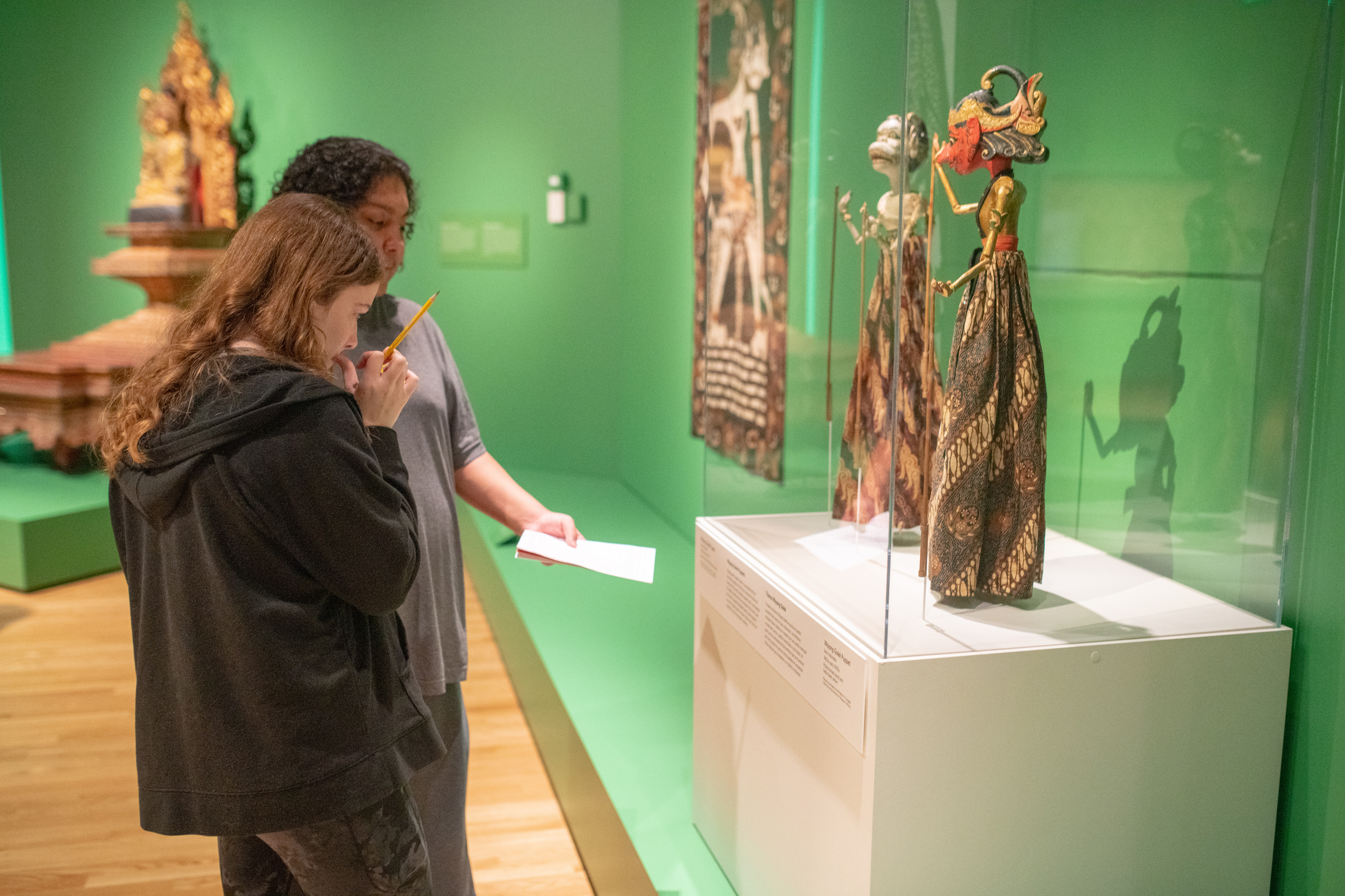This Denver Art Museum field trip experience develops young people’s ability to critically reflect on power dynamics in society and grapple with social justice issues that are important to them. This field trip plants seeds of inquiry and offers students tools for contemplation. Students interrogate the complex topics of power and privilege, both of which intersect with all aspects of society, including art. Through this experience at the DAM, students develop themselves as responsible global citizens, with tools to disrupt and challenge systemic and individual issues when they see them.
Our 90-minute experiences for high school students spark curiosity and investigation through a combination of docent-led and self-guided activities in the art galleries. Each small group experience will be led by the chaperone with the assistance of investigation journals and museum staff.
Power and Privilege Lens goals:
- Identify ways power manifests throughout artwork
- Examine the role of power dynamics in the artworld and identify its impact on one’s own experience
- Explore the role of art and artists in societal issues of justice and equity
- Generate dialogue and critical awareness about social issues
Why are we using this format?
We aim to foster critical thinking by sparking dialogue about relevant topics inspired by works of art. By allowing for more time exploring works of art semi-independently, we create a memorable learning experience where students feel a stronger connection because they are able to follow their own personal interests.
Standards
Visual Arts Standards:
- Sixth Grade, Standard 1.3. Observe and Learn to Comprehend. Utilize key concepts, issues and themes to connect the visual arts to other disciplines.
- Sixth Grade, Standard 2.1. Envision and Critique to Reflect. Interpret meaning and evaluate works of visual art and design recognizing diverse points of view.
- Sixth Grade, Standard 2.2. Envision and Critique to Reflect. Describe, analyze and interpret works of art using specific art vocabulary.
- Sixth Grade, Standard 4.1. Relate and Connect to Transfer. Infer from works of visual art and design, using interdisciplinary knowledge, how diverse communities address issues relevant to their culture, place and times.
- Sixth Grade, Standard 4.2. Relate and Connect to Transfer. Investigate art and other careers that use creative and design thinking.
- Sixth Grade, Standard 4.3. Relate and Connect to Transfer. Investigate how art addresses contemporary issues and community and societal concerns.
- Seventh Grade, Standard 1.1. Observe and Learn to Comprehend. Recognize and interpret works of art through the lens of time, place and culture.
- Seventh Grade, Standard 1.2. Observe and Learn to Comprehend. Analyze works of art and apply the language of visual art and design to infer meaning.
- Seventh Grade, Standard 1.3. Observe and Learn to Comprehend. Employ concepts, issues and themes from other disciplines to solve visual arts problems.
- Seventh Grade, Standard 2.1. Envision and Critique to Reflect. Determine meaning from works of art and design using visual literacy skills such as interpretation, negotiation, appreciation and selection.
- Seventh Grade, Standard 2.2. Envision and Critique to Reflect. Utilize appropriate vocabulary in the critical analysis of works of art.
- Seventh Grade, Standard 4.1. Relate and Connect to Transfer. Investigate how artists, designers and scholars narrate their social context.
- Seventh Grade, Standard 4.2. Relate and Connect to Transfer. Identify where the visual arts and artistic thinking are present in the real world.
- Seventh Grade, Standard 4.3 Relate and Connect to Transfer -Communicate messages about societal problems through the creative process.
- Eighth Grade, Standard 1.1. Observe and Learn to Comprehend. Interpret works of art using the language of visual art and design and conceptual art frameworks.
- Eighth Grade, Standard 1.2. Observe and Learn to Comprehend. Synthesize and evaluate how time, culture and artistic style relates to contemporary art concerns.
- Eighth Grade, Standard 1.3. Observe and Learn to Comprehend. Apply key concepts, issues and themes of the visual arts to solve problems using real-world applications.
- Eighth Grade, Standard 2.1. Envision and Critique to Reflect. Utilize visual literacy skills to establish personal meaning and interpret the artistic intent of others.
- Eighth Grade, Standard 2.2. Envision and Critique to Reflect. Analyze, interpret and make informed judgments about works of art using different points of view.
- Eighth Grade, Standard 4.1. Relate and Connect to Transfer. Interpret the ways individual makers become agents that express the interdependent relationship between art, culture and social contexts.
- Eighth Grade, Standard 4.2. Relate and Connect to Transfer. Discern and articulate the impact arts, design and creativity have on a variety of lifelong endeavors.
- Eighth Grade, Standard 4.3. Relate and Connect to Transfer. Demonstrate an understanding that art can be a vehicle for social change.
- High School, Standard 1.1. Observe and Learn to Comprehend. Utilize the inquiry method of observation and the language of visual art and design to gather information and determine meaning.
- High School, Standard 1.2. Observe and Learn to Comprehend. Interpret, analyze and explain the influence of multiple contexts found in visual art and design.
- High School, Standard 1.3. Observe and Learn to Comprehend. Use artmaking processes as forms of inquiry to increase independent reasoning and perception skills to increase knowledge.
- High School, Standard 2.1. Envision and Critique to Reflect. Use criteria and personal discernment to evaluate works of art and design, taking into consideration the variables that influence how the work is perceived.
- High School, Standard 2.3. Envision and Critique to Reflect. Examine the nature of diverse aesthetic experiences to build a language of representation that can be used to respond to the world.
- High School, Standard 4.1. Relate and Connect to Transfer. Research and analyze the ways visual artists, designers and scholars express personal views and beliefs and how these perspectives have a social context that enlarges the meaning of an artwork beyond the individual maker.
- High School, Standard 4.3. Relate and Connect to Transfer. Utilize the practice of artmaking, and research historical and cultural contexts, to discern between different viewpoints, critique social problems and effect social change.
Reading, Writing, and Communicating Standards:
- Ninth / Tenth Grade Band, Standard 4.1. Research Inquiry and Design. Synthesize multiple, authoritative literary and/or informational sources, creating cohesive research projects that show an understanding of the subject.
Social Studies Standards:
- High School, Standard 3.4. Economics. Globalization and international trade affect the allocation of goods, services, and resources.
- High School, Standard 2.3. Geography. The interconnected nature of the world, its people and places.
- High School, Standard 1.1. History. Use the historical method of inquiry to formulate compelling questions, evaluate primary and secondary sources, analyze and interpret data, and argue for an interpretation defended by textual evidence.
- Seventh Grade, Standard 1.1. History. Use a variety of primary and secondary sources from multiple perspectives to formulate an appropriate thesis supported by evidence.
Prepare for Your Visit
Teachers and chaperones, you will accompany students as you complete three carefully-designed activities in the exhibit spaces. As a chaperone, you will be guiding your small group of students through two of the three activities during your time in the galleries.
Facilitation for these activities will be detailed in your chaperone journal (see below), which you will receive upon arrival at the museum. It may be helpful to familiarize yourself with this tool beforehand.
Chaperone tasks include:
- Wayfinding
- Assisting students in starting their activities
- Timekeeping
- Leading a group reflection conversation using the chaperone journal tool at the end of each activity.
Here are two helpful resources. There is no need to print out or bring either to your visit.
- Chaperone journal: A digital copy of the guide you will receive to lead students through the galleries. Each guide includes examples for each activity, discussion prompts, helpful tips, and more.
- Chaperone journal in Spanish.
- The Art of Chaperoning, a printable PDF with chaperone guidelines and helpful tips.
Post-Visit Materials
After your visit, dig deeper into the ideas explored in the power and privilege fieldtrip experience using these lesson plans as a resource in your classroom.
Related Creativity Resources

Art and Social Consciousness: Identity Lens

Art and Social Consciousness: Environmental Lens
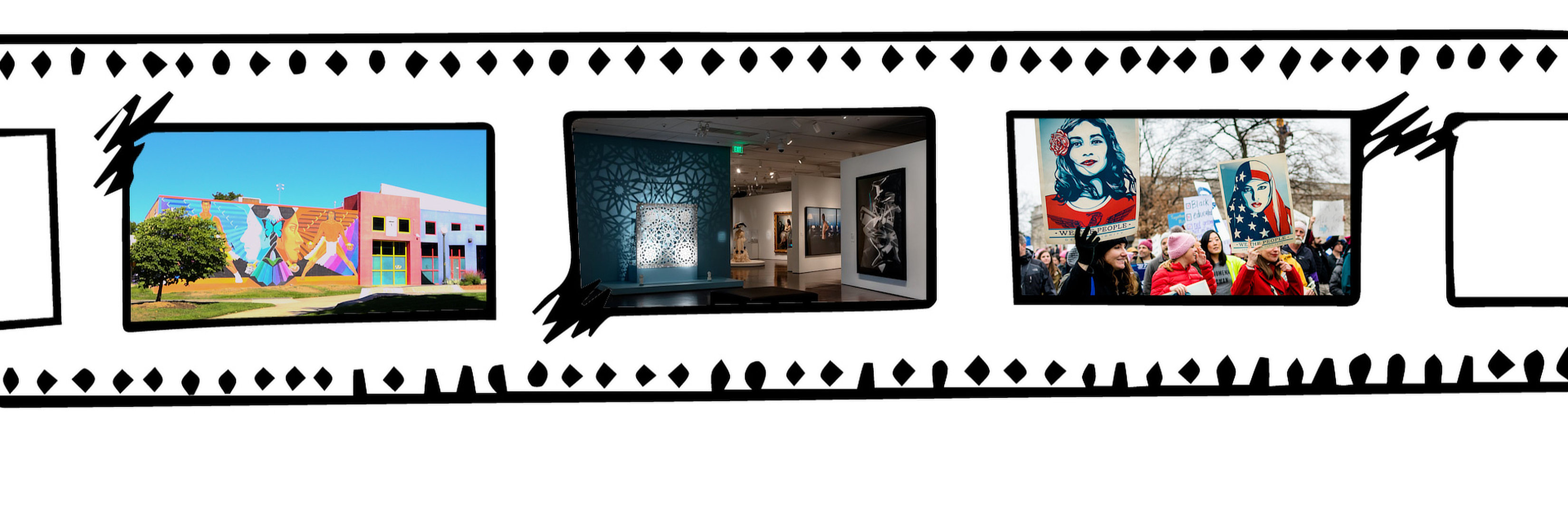
Art and Social Consciousness
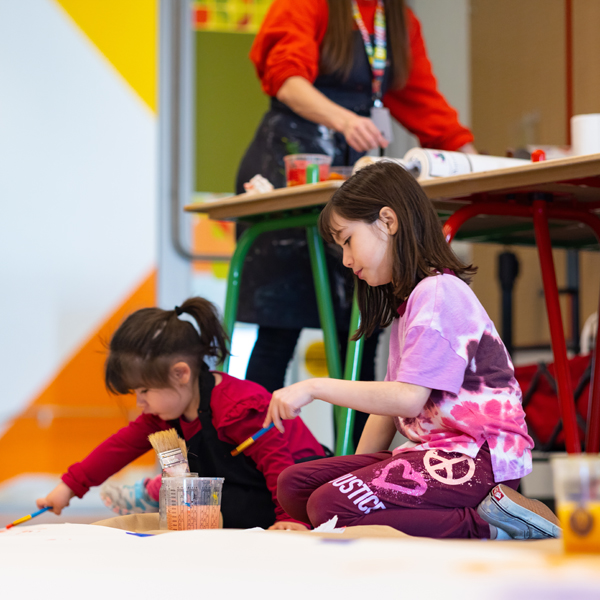
Homeschool Program Day
